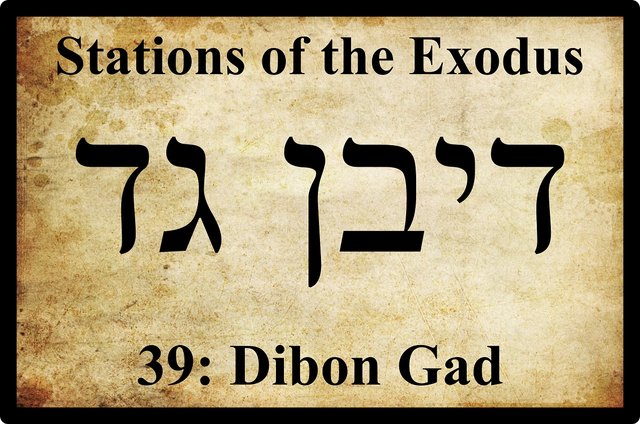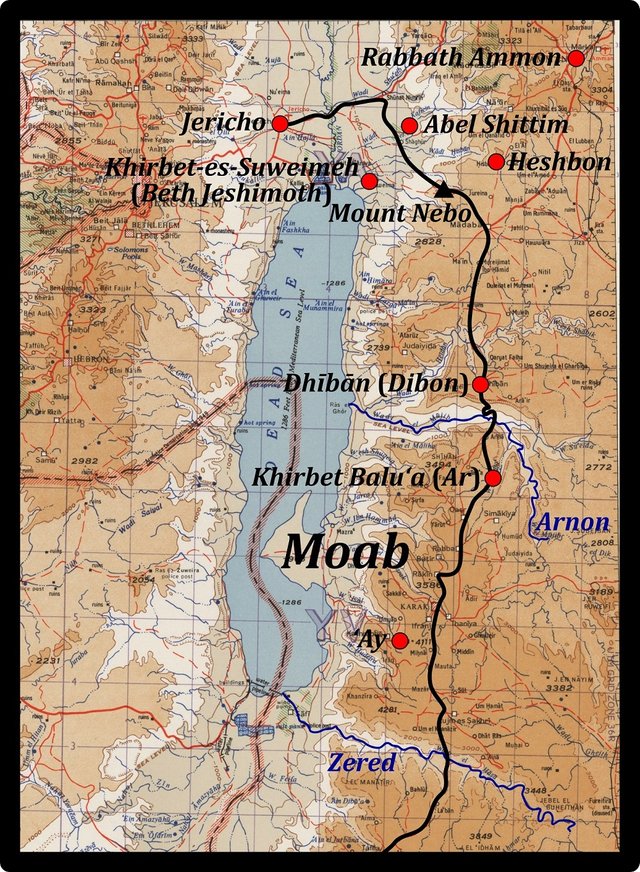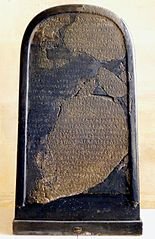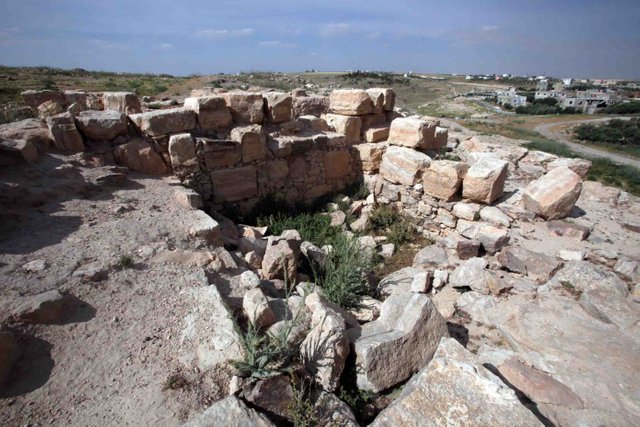
According to the catalogue of the Stations of the Exodus in Chapter 33 of the Book of Numbers, the thirty-ninth station was a place called Dibongad:
And they departed from Iim, and pitched in Dibongad. And they removed from Dibongad, and encamped in Almondiblathaim. And they removed from Almondiblathaim, and pitched in the mountains of Abarim, before Nebo. And they departed from the mountains of Abarim, and pitched in the plains of Moab by Jordan near Jericho. And they pitched by Jordan, from Bethjesimoth even unto Abelshittim in the plains of Moab. (Numbers 33:45-49)
The main Exodus narrative in Numbers 21, however, is quite different and does not mention any such place as Dibongad:
And they journeyed from Oboth, and pitched at Ijeabarim, in the wilderness which is before Moab, toward the sunrising. From thence they removed, and pitched in the valley of Zared. From thence they removed, and pitched on the other side of Arnon, which is in the wilderness that cometh out of the coasts of the Amorites: for Arnon is the border of Moab, between Moab and the Amorites. Wherefore it is said in the book of the wars of the Lord, What he did in the Red sea, and in the brooks of Arnon, And at the stream of the brooks that goeth down to the dwelling of Ar, and lieth upon the border of Moab. And from thence they went to Beer: that is the well whereof the Lord spake unto Moses, Gather the people together, and I will give them water. Then Israel sang this song, Spring up, O well; sing ye unto it: The princes digged the well, the nobles of the people digged it, by the direction of the lawgiver, with their staves. And from the wilderness they went to Mattanah: And from Mattanah to Nahaliel: and from Nahaliel to Bamoth: And from Bamoth in the valley, that is in the country of Moab, to the top of Pisgah, which looketh toward Jeshimon. (Numbers 21:11-20)
There is some overlap between these two accounts:
Pisgah and Nebo are generally considered to refer to one and the same mountain, an equation that is justified by a passage in Deuteronomy: And Moses went up from the plains of Moab unto the mountain of Nebo, to the top of Pisgah, that is over against Jericho. (Deuteronomy 34:1)
Bethjesimoth and Jeshimon may refer to one and the same place. The former has been tentatively identified with Khirbet-es-Suweimeh, which is close to the mouth of the River Jordan, near the northern shore of the Dead Sea (Orr 449, 1622).
The location of Dibongad itself, however, seems clear:
The exact names Dibon-gad, Almon-diblathaim, and Abel-shittim are also unique to this passage, but they clearly correspond to Dibon, Beth-diblathaim, and Shittim well known in other texts. It seems safe to associate Punon with Khirbet el-Feinan in Wādī el-Feinan and Dibon(-gad) with Dhībān immediately north of Wādī Mūjib. (Miller 581)

It is generally acknowledged that Dibon was the original name of the place. It acquired the suffix -gad at a later date when it and the surrounding territory were occupied by the Tribe of Gad:
It was taken and given to the tribe of Gad, whence it is called Dibon-gad (Nu 32 34; 33 45). (Orr 843)
Dibon was the capital of Moab under Mesha, whose reign was contemporary with that of Jehoram King of Israel. In the famous Mesha Stele or Moabite Stone, the authenticity of which has often been questioned, Mesha calls himself the Dibonite. It is uncertain, however, whether Dibon existed at the time of the Exodus:

Dibon, a capital of Moab under Mesha king of Moab circa 840/830, is readily admitted to be located at modern Dhiban, just north of the Arnon (Wadi Mujib). The archaeology of the site is very fragmentary and incomplete, with (so far) no recovery of Late Bronze/Iron I-IIA remains. But by contrast, Ramesses II in the thirteenth century not only mentions Moab in a topographical list but also depicts himself warring in Moab, and capturing five named forts. In the original texts (later written over in palimpsest), the first was named as Dutartu “in the land of Moab”; the second, “Yan(?)d|. . .] in the mountain of Mararuna”; the third as Dibon; while the fourth and fifth are lost (although there are traces for the fifth). The reading of Dibon is beyond doubt, and is clinched by the immediate context of Moab with Butartu, for which Moabite locales seem dear. In each case the Egyptian text calls each place a dmi, or settlement, a term with which the “foreign fort” representation agrees in each case. (Kitchen 195)
According to the Short Chronology, which I am following, Ramesses II flourished about two centuries after the Exodus.

From Ije Abarim to Dibongad
In the previous article, we surmised that the Ije Abarim and Iim of Numbers 33 and the valley of Zared of Numbers 21 referred to one and the same place, located somewhere in the valley of the Wādī el-Ḥesā, which formed the southern boundary of Moab. We also noted that a site in the valley of the Wādī el-Ḥesā would still be about 60 km short of Dhībān. If the Israelites were covering 24-32 km per day (Hoffmeier 120), there must have been at least one more station before the latter—possibly two. Perhaps these included one or more of the other places mentioned in Numbers 21: Beer, Mattanah, Nahaliel and Bamoth (Clarke 686).
Another possibility is that Ije Abarim and the valley of Zared were two different stations between Oboth and Dibon-gad. This allows us to locate Ije Abarim somewhere between the Wādī el-Ḥesā and Dhībān, though this reverses the order given in Numbers 21, which places Ije Abarim before the valley of Zared. This idea is not entirely new, and we already considered this possibility in the previous article:
Davies identifies Iye-abarim with the present-day village of ‘Ay approximately ten kilometers southwest of Kerak. The possibility must be considered, however, that Iye-abarim ... was not a specific site—that is, that the name should be translated with full appellative force, something like “the ruins on the other side.” Certainly this is true of the Mountains of Abarim ... which would be the rugged western escarpment of the Moabite plateau at the northeastern corner of the Dead Sea. (Miller 581)
‘Ay, however, is perhaps too close to the Wādī el-Ḥesā (20 km) and too far from Dhībān (40 km) to be the ideal candidate, but it’s not impossible. Close to ‘Ay—about 5 km to the east—is a place called Miḥnā. Could this be Mattanah? Unlikely. According to Numbers 21 Beer, Mattanah, Nahaliel and Bamoth came after Ar, and in the previous article we saw that the best candidate for Ar is Khirbet Balu’a, which lies about 30 km north of Miḥnā. Perhaps Mattanah refers to Ma’īn, which lies about 20 km north of Dhībān.
The identities of Beer, Mattanah, Nahaliel and Bamoth remain unknown. Beer means well (Orr 424), while Mattanah means gift (Orr 2008), but the locations to which these toponyms refer are not known.
Nahaliel means torrent valley of God (Orr 2109), so it probably refers to one of the wadis between the Arnon (Wadi el-Mūjib) and the Jordan.
Bamoth means high places (Orr 381) and has been identified with a later settlement called Bamoth-Baal, which was allotted to the Tribe of Reuben (Joshua 13:17). Apparently, this lay somewhere north of the Arnon, in the territory ruled by Sihon the Amorite at the time of the Exodus, but its exact location remains a matter of speculation. Mesha claims to have rebuilt a town called Bethbamot, which was probably the same place.

Conclusion
Dibongad of Numbers 33 refers to the settlement known today as Dhībān, but it remains uncertain whether this was a genuine Station of the Exodus, or whether it even existed at the time of the Exodus. It is probably safe to say that in their final approach to Canaan the Israelites passed within the vicinity of this place.
To be continued ...
References
- Adam Clarke, The Holy Bible ... With a Commentary and Critical Notes, Volume 1, G Lane & C B Tippett, New York (1846)
- James K Hoffmeier, Ancient Israel in Sinai: The Evidence for the Authenticity of the Wilderness Tradition, Oxford University Press, Oxford (2005)
- Kenneth A Kitchen, On the Reliability of the Old Testament, William B Eerdmans Publishing Company, Grand Rapids MI (2003)
- J Maxwell Miller, The Israelite Journey through (Around) Moab and Moabite Toponymy, Journal of Biblical Literature, Volume 108, Number 4, pp 577-595, The Society of Biblical Literature, Atlanta, GA (1989)
- James Orr (General Editor), The International Standard Bible Encyclopedia, Volume 1, Volume 2, Volume 3, The Howard-Severance Company, Chicago (1915)
Image Credits
- Moab and Transjordan: University of Texas Libraries, Perry-Castañeda Library Map Collection, Jerusalem, D Survey, Great Britain War Office and Air Ministry (1960), Public Domain
- Mesha Stele: Louvre Museum, AO5066, © 2012 Mbzt , Creative Commons License
- Dhībān: Copyright Unknown, Fair Use
- Wādī el-Mūjib (The Arnon Stream): © Berthold Werner, Creative Commons License
